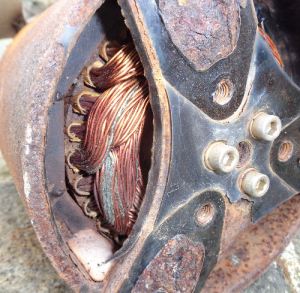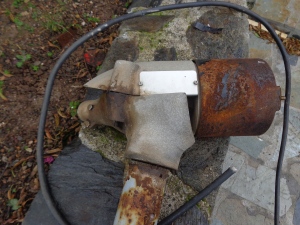If you think that natural elements do not affect considerably your wind generator then think twice. The photos show a wind generator after 7 years on the run on a 13m mast near the sea. The rotor has gone. The magnets on the rotor do touch the stator due to rust expansion and parts of the magnets are missing due to friction with the stator, not to mention that the rotor doesn’t rotate no mater how much force you apply. The electrical isolation of the stator coils has also peeled off giving lots of short circuited points. The hinge that protects the generator from the high winds (mechanical rpm regulator) has stuck.
This wind generator, even if re-wired and reconditioned is neither reliable nor safe to operate. Unfortunatelly this is the end of its life.
There are a few points to consider if you want to maximise the life of your wind turbine.
A land model, although more economic, is not a proper selection if you are close to the sea or in a very humid location (That was the main mistake of the owner for this case). Most companies, like the one considered here, have marine models that can deal much better under extreme weather conditions.
You need to maintain your generator once a year specially in very windy and humid locations. That means that you need to take it down from the mast and check for signs of potential problems. That is the reason you also need to properly design your mast system. You need to make it easy and safe to lower down.
Use a proper grease to all moving or rotating joints. High temperature-Marine lithium grease is, in our experience, one of the best that will last for many months with no problem. If you want to be sure that the screws will come out easily, next time you want to maintain your generator, use graphite grease on the threads. Always use a torque wrench and follow the manufacturer’s advice.
Take out the rust carefully and repaint any part of the generator that needs it.
Check all the plastic parts carefully as they are the most likely to fail. Check the wind turbine blades. We recommend changing them every 6 years even if visually look OK to avoid fatal accidents (if the blades break during strong winds they can kill). Have in mind that even with the best possible materials, UV radiation, high centrifugal forces, vibrations, exposure to salt, water etc have a great effect on the strength of the blades after some years.
Check and replace or clean (if needed) the slip rings, measure their electrical resistance. Change the bearings if necessary or add some grease to them if dry.
Make sure that under storm conditions or prolonged absence you switch off your wind turbine since the automatic protection may not be enough for all models and under all weather conditions.
Always read the manufacturer’s maintenance and operations manual very carefully.
Do not assume anything… if you are not sure what to do ask for the help of a qualified, registered professional.


